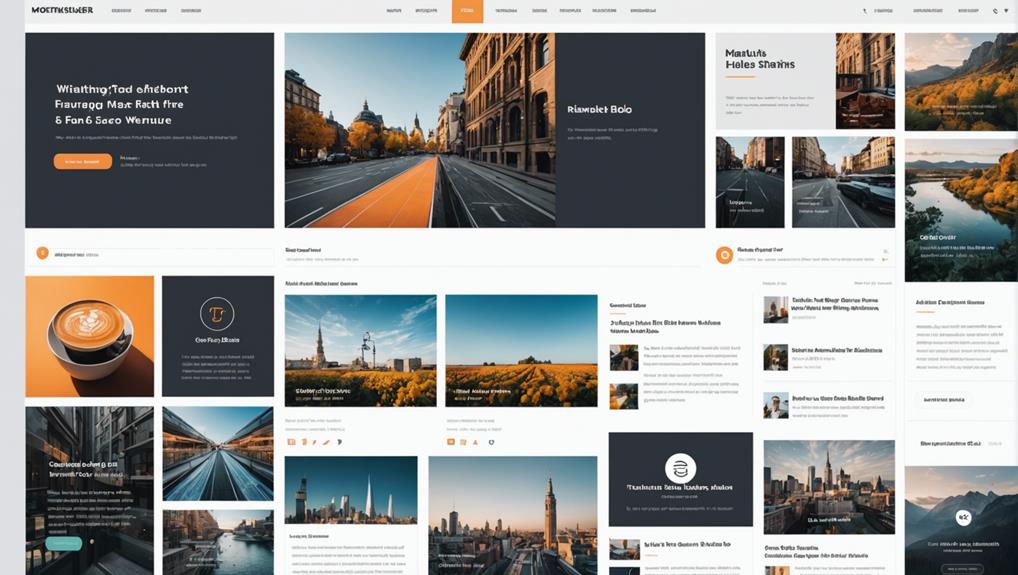Launching a blog? First, set clear goals and identify your target audience. Choose a blogging platform like WordPress or Squarespace. Secure a domain that mirrors your brand and reliable hosting with SSL and backup options. Customize your blog's design with a responsive theme, consistent color scheme, and essential features. Install important plugins like Yoast for SEO and Jetpack for performance. Craft engaging, keyword-rich content with compelling titles and visuals. Optimize for SEO with internal links and meta descriptions. Promote your blog effectively. Follow these steps, and you'll be on track to boost your online presence and attract readers. Learn more to get detailed insights.
Key Takeaways
- Set clear, measurable goals and define a timeline for your blog launch.
- Register a domain and select a reliable hosting provider with excellent customer support.
- Choose a responsive theme and customize it to reflect your brand identity.
- Install essential plugins for SEO, performance, engagement, and spam filtering.
- Optimize content with engaging titles, meta descriptions, visual elements, and keyword integration.
Set Clear Goals
Setting clear and measurable goals is vital for ensuring your blog launch is both organized and successful. Effective goal setting will give you a roadmap for your launch, helping you define specific targets such as reaching a certain number of subscribers or page views within a set timeframe. Start by aligning your goals with your overall blogging aspirations and the needs of your target audience. This guarantees your objectives aren't only realistic but also relevant.
Next, create a timeline to achieve these goals. By breaking down your objectives into manageable tasks with deadlines, you'll stay organized and focused throughout the process. Progress tracking is essential here; regularly monitor your metrics to see how close you're to reaching your targets. This not only helps you stay on course but also allows you to adjust your strategies as needed.
Incorporate motivation techniques to keep yourself accountable. Set smaller milestones and celebrate each achievement to maintain momentum. Audience research can also play a significant role in refining your goals, ensuring they're tailored to attract and retain your ideal readers. With clear objectives and a structured approach, your blog launch is set up for success.
Identify Target Audience
Understanding your target audience is essential for ensuring your blog content resonates and drives engagement. Start with a thorough audience analysis to pinpoint who your readers are. Conduct market research to identify key demographics and interests. Tools like Google Analytics can be invaluable for analyzing website traffic and audience behavior, providing insights into what content your visitors prefer and how they interact with your site.
Next, develop a targeting strategy by creating detailed customer personas. These personas should represent your ideal readers and include information such as age, gender, occupation, and hobbies. Tailor your content to address their specific needs and preferences, making it more relevant and engaging.
Engaging directly with your audience through surveys, polls, and social media can also provide critical feedback. This interaction not only helps refine your targeting strategy but also fosters a sense of community and loyalty among your readers.
Choose Your Blogging Platform
Selecting your blogging platform is essential for your blog's success. With WordPress powering over 35% of websites due to its versatility and customization options, it's a strong contender.
However, user-friendly alternatives like Squarespace offer seamless setup with visually appealing templates, so compare platform features and user interface ease to find the best fit.
Platform Feature Comparison
When you're prepared to start blogging, choosing the right platform is essential, and with WordPress powering 39.5% of all websites, it's a top contender. WordPress offers extensive customization options and a vast template variety, allowing you to build a unique and engaging blog. Its robust SEO integration guarantees your content is optimized for search engines, driving more traffic to your site. Additionally, WordPress excels in mobile responsiveness, guaranteeing your blog looks great on any device.
Squarespace is another excellent option, known for its beautifully designed templates that make your blog visually appealing from the get-go. It also provides strong mobile responsiveness and SEO integration, making it easier for readers to find and enjoy your content on any platform.
Wix stands out with its intuitive drag-and-drop editor, making customization straightforward, even for beginners. With a wide array of templates and mobile-friendly designs, Wix ensures your blog is both attractive and functional.
For those seeking simplicity, Blogger, owned by Google, offers a free and easy way to start blogging quickly, though it may lack the advanced features of other platforms.
On the other hand, Medium focuses on a clean design and storytelling, ideal for writers who prioritize content over customization.
User Interface Ease
After comparing platform features, an intuitive user interface can greatly enhance your blogging experience, making WordPress, Squarespace, Wix, Blogger, and Medium worth your consideration. WordPress, with over 40% of websites using it, offers extensive customization and plugins but might require a learning curve. Squarespace is perfect for beginners due to its drag-and-drop interface, while Wix provides visually appealing templates that are easy to customize.
| Platform | User Interface | Best For |
|---|---|---|
| WordPress | Customizable, Plugin-rich | Advanced Users |
| Squarespace | Drag-and-Drop | Beginners |
| Wix | Visually Appealing | Designers |
| Blogger | Simple, Free | Basic Blogging Needs |
| Medium | Minimalist | Writers and Readers |
When choosing a platform, consider accessibility testing and mobile optimization to make certain your blog is user-friendly across devices. WordPress excels in these areas due to its vast plugin ecosystem. Squarespace and Wix are also strong contenders, thanks to built-in mobile optimization features. Collect user feedback and conduct A/B testing to refine your blog's interface. Platforms like Medium and Blogger, with their straightforward interfaces, can be improved through user feedback loops to enhance reader engagement. Remember, a seamless user experience is key to retaining readers and boosting SEO rankings.
Register Domain and Hosting
Now that you've chosen your blogging platform, it's important to register a domain name that mirrors your brand and is easy to recall.
Opt for a reliable hosting provider like Bluehost or SiteGround to guarantee your site runs smoothly, as 53% of mobile users abandon sites that take over 3 seconds to load.
Secure your domain with a reputable registrar and consider domain privacy protection to keep your personal information safe.
Choosing Reliable Hosting Provider
Selecting a vital hosting provider like SiteGround is essential for guaranteeing your blog's uptime, speed, and security. When choosing a hosting provider, prioritize customer support reliability and uptime guarantees.
SiteGround, for example, boasts a 99.99% uptime guarantee and 24/7 customer support, ensuring your blog remains accessible round the clock. This reliability can greatly impact your blog's success, as downtime can deter visitors and harm your SEO rankings.
Beyond uptime and support, consider the backup options and SSL certificates offered by the provider. SiteGround provides daily backups and free SSL certificates, which are critical for protecting your data and establishing trust with your audience. An SSL certificate not only secures your site but also boosts your search engine rankings, making it an indispensable feature.
Additionally, look for hosting plans that facilitate easy blog setup, such as one-click WordPress installations. This feature can save you time and reduce technical headaches during the initial setup phase.
Lastly, always read customer reviews to gauge real-world experiences and ensure the provider lives up to its promises. Making an informed choice in hosting sets a solid foundation for your blog's future growth.
Securing Your Domain Name
Once you've chosen a reliable hosting provider, the next step is to secure your domain name, a critical component for establishing your blog's online identity. Registering a domain name is the first move in building your online presence. Aim for a .com domain to enhance brand credibility and recognition, as it's the most trusted and recognizable domain extension.
Many hosting providers offer free domain registration for new customers, which can save you some initial costs. When selecting your domain, consider domain privacy and security features. Domain privacy helps protect your personal information from public databases, keeping your contact details safe from spammers and cyber threats.
Pricing varies among providers, so compare options to make sure you're getting the best deal without compromising on essential features like security. Look for packages that include SSL certificates, which are vital for securing data transmission and improving your blog's SEO ranking.
Design Your Blog
Crafting an engaging and visually appealing blog starts with choosing a responsive theme that aligns with your brand's aesthetic and offers easy navigation. A responsive theme guarantees your blog looks great on all devices, which is vital for retaining readers.
Begin by selecting color palettes that reflect your brand identity and evoke the right emotions. Consistency in your color scheme can increase brand recognition by up to 80%.
Next, focus on your logo design. A well-designed logo is the cornerstone of your brand's visual identity and helps create a professional appearance. Place your logo prominently on the header to make it easily recognizable.
Customizing your blog theme is essential. Include a sidebar with engaging content like recent posts or social media feeds, and a contact form for user interaction. Good typography is a necessity; choose fonts that enhance readability and complement your overall design.
Additionally, set up a Primary Menu Bar with clear categories to help visitors navigate your blog effortlessly. By making your blog visually appealing and user-friendly, you're more likely to attract and retain readers, ultimately boosting your SEO performance.
Install Essential Plugins
Optimizing your blog's functionality and performance starts with installing essential plugins like Yoast for SEO and Jetpack for enhanced website performance. These plugins are vital for improving your blog's search engine visibility and overall user experience.
To guarantee your blog runs smoothly, focus on these key plugins:
- Contact Form 7: This plugin allows for easy setup of a contact form, facilitating visitor inquiries and engagement. It's highly customizable and supports various types of forms, ensuring compatibility with your blog's theme.
- UltimatelySocial: Seamlessly integrate your social media accounts with your blog using UltimatelySocial. This plugin offers extensive customization options, enabling you to tailor the social sharing buttons to match your blog's aesthetic perfectly.
- Akismet: Keep your blog clean and professional by combating spam comments with Akismet. It's a powerful tool that filters out unwanted content, ensuring your comment section remains relevant and engaging for your audience.
Besides these, consider installing Termly to create important legal pages like Privacy Policy for compliance purposes. Always check for plugin compatibility with your blog's theme and other plugins to prevent conflicts.
Create Engaging Content
Creating engaging content is the cornerstone of a successful blog, as it captivates readers and drives traffic through well-optimized, keyword-rich articles. Your content strategy should start with crafting compelling titles and meta descriptions that grab attention.
Use high-quality images and multimedia elements, as visual content can boost audience engagement considerably. Data indicates that articles with relevant images get 94% more views than those without.
Incorporate relevant keywords naturally within your content to enhance its visibility, but remember, it's all about balance. Overloading your blog post with keywords can harm readability and user experience.
Internal links are another critical aspect of your content strategy. By linking to other relevant blog posts, you create a seamless navigation experience, retaining readers on your site longer and increasing the chances they'll explore more of your content.
Optimize for SEO
Boosting your blog's visibility through SEO optimization can greatly increase your organic traffic and overall site performance. Implementing effective SEO tactics can amplify your reach by up to 200%.
Here are some key strategies to get you started:
- Keyword Research and Content Optimization:
Begin by conducting thorough keyword research to identify high-traffic terms relevant to your niche. Tools like Google Keyword Planner can be invaluable. Integrate these keywords naturally into your content, titles, and meta descriptions to enhance visibility. Don't forget to change your permalink structure to include these keywords, as this can greatly improve your SEO ranking.
- Backlink Building and Social Media Strategies:
Building a robust backlink profile is important. Seek out opportunities for guest blogging and collaborations to earn high-quality backlinks. Additionally, leverage social media strategies to share your content widely, which can attract more backlinks and boost your SEO.
- Technical Optimization:
Install SEO plugins like Yoast to help you optimize your blog posts effectively. Make sure your site uses SSL for secure connections, as this improves both your credibility and SEO ranking. Finally, utilize Google Analytics and Search Console to gain valuable insights and refine your SEO strategies.
Promote Your Blog
Utilizing the power of social media platforms like Facebook, Twitter, and Instagram can greatly amplify your blog's reach and drive substantial traffic to your site. Start by sharing your blog posts regularly on these platforms, ensuring each post is engaging and includes trending hashtags to increase visibility.
Incorporate viral content strategies by creating shareable graphics or videos that resonate with your audience.
Influencer partnerships are a powerful way to expand your blog's visibility. Collaborate with influencers in your niche to tap into their followers and boost your credibility. Influencers can share your blog posts or even write guest posts, driving their audience to your site.
Running giveaway campaigns on your blog or social media channels can also attract new readers and engage your current audience. A well-executed giveaway can generate excitement and increase your blog's exposure.
Don't forget to leverage email marketing services like Mailchimp or ConvertKit. Regularly send newsletters featuring your latest blog posts to keep your subscribers engaged and returning to your site.
Frequently Asked Questions
What Are the 7 Steps to Write an Awesome Blog Post?
To write an awesome blog post, start with audience research, then outline your content. Craft a strong headline, use SEO strategies, write an engaging introduction, include visuals, and edit thoroughly for clarity and impact.
What Is the 8 Essential Elements of a Successful Blog Post?
To craft a successful blog post, incorporate an engaging headline, strategic keywords, high-quality visuals, and a strong CTA. Guarantee ideal content length and post formatting with subheadings and bullet points to enhance readability and SEO.
How to Start a Blog Checklist?
To start a blog, choose a memorable domain name, secure reliable hosting, install WordPress, and create a content calendar. Develop a branding strategy and use SEO tactics to boost visibility and drive traffic to your blog.
How Do I Start an Ultimate Blog Guide?
To start an ultimate blog guide, identify your audience and plan your content meticulously. Focus on creating high-quality, engaging posts. Use SEO strategies to boost visibility and continuously analyze performance for improvements.
Conclusion
You've got everything you need to launch your blog with confidence. By setting clear goals, identifying your target audience, and choosing the right platform, you're on the path to success.
Don't forget to register your domain, design your blog, and install essential plugins. Create engaging content and optimize for SEO to make certain your blog stands out.
Promote your blog widely to attract readers. Follow this checklist, and you'll be well on your way to blogging success!




